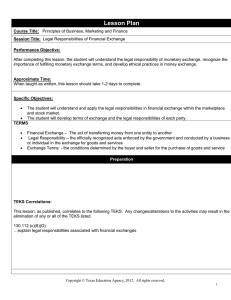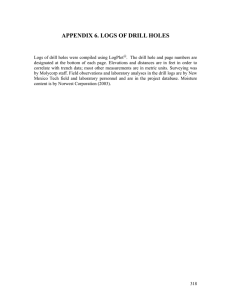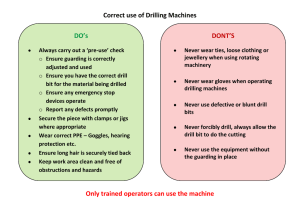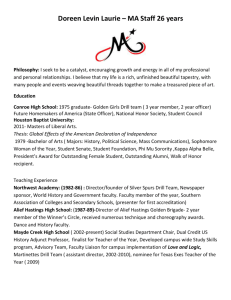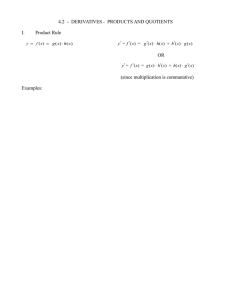Lesson Plan
advertisement
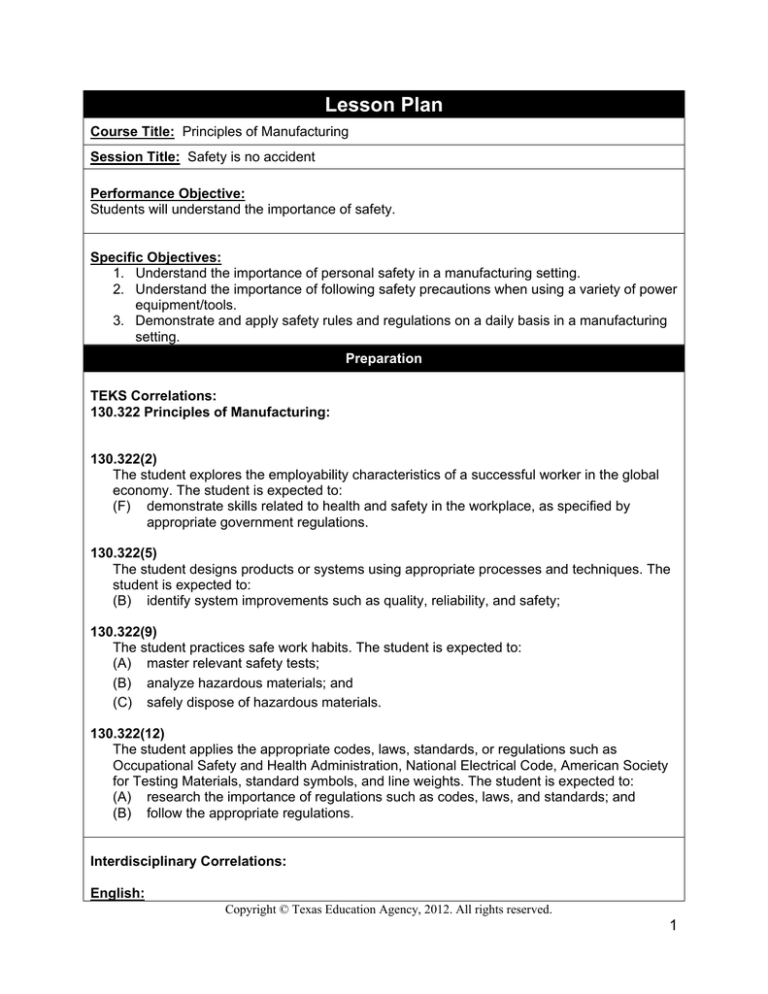
Lesson Plan Course Title: Principles of Manufacturing Session Title: Safety is no accident Performance Objective: Students will understand the importance of safety. Specific Objectives: 1. Understand the importance of personal safety in a manufacturing setting. 2. Understand the importance of following safety precautions when using a variety of power equipment/tools. 3. Demonstrate and apply safety rules and regulations on a daily basis in a manufacturing setting. Preparation TEKS Correlations: 130.322 Principles of Manufacturing: 130.322(2) The student explores the employability characteristics of a successful worker in the global economy. The student is expected to: (F) demonstrate skills related to health and safety in the workplace, as specified by appropriate government regulations. 130.322(5) The student designs products or systems using appropriate processes and techniques. The student is expected to: (B) identify system improvements such as quality, reliability, and safety; 130.322(9) The student practices safe work habits. The student is expected to: (A) master relevant safety tests; (B) analyze hazardous materials; and (C) safely dispose of hazardous materials. 130.322(12) The student applies the appropriate codes, laws, standards, or regulations such as Occupational Safety and Health Administration, National Electrical Code, American Society for Testing Materials, standard symbols, and line weights. The student is expected to: (A) research the importance of regulations such as codes, laws, and standards; and (B) follow the appropriate regulations. Interdisciplinary Correlations: English: Copyright © Texas Education Agency, 2012. All rights reserved. 1 110.xx(6)(A) – Vocabulary Development …Expand vocabulary through…listening and discussing… 110.xx(6)(B) – Vocabulary Development …Rely on context to determine meanings of words… Math: 111.36 M.1A Compare and analyze various methods for solving a real-life problem. Integrated Physics and Chemistry: 112.42(1)(A) Demonstrate safe practices during field and laboratory investigations. Teacher Preparation: References: Komeck, Lawson, and Horton. Manufacturing Technology (Delmar: 1990). Instructional Aids: 1. 2. 3. 4. Personal Safety Rules PowerPoint Vocabulary PowerPoint Vocabulary Handout Safety is no accident rubric Materials Needed: 1. Poster board (for the safety poster activity) 2. Markers 3. Note taking paper 4. Safety equipment (goggles, gloves, ear protectors, etc.) Equipment Needed: 1. Computer with PowerPoint 2. Infocus projector Learner Preparation: VOCABULARY: Safety OSHA Safe eye wear Hearing protection Proper clothing Introduction Introduction (LSI Quadrant I): Copyright © Texas Education Agency, 2012. All rights reserved. 2 SAY: We have discussed several important concepts related to the manufacturing process. However, one new area is of extreme importance to you and our class as we work with tools and equipment. This area is called safety. Safety can be divided into 2 main groups—personal safety and safe practices that are designed to protect you and equipment/tool safety. These are rules designed to protect not only you but also the equipment and tools we have in our lab. (Allow 10-12 minutes for the power point and note taking.) Outline Outline (LSI Quadrant II): Instructors can use the PowerPoint presentation, slides, handouts, and note pages in conjunction with the following outline. MI Outline Notes to Instructor Using the power point titled, “Personal Safety Rules,” District policies may that you have each student copy the presentation word for dictate provided IEP students word as you go through it. with a copy of the information without taking the notes. I would suggest that you have all students . attempt to copy this presentation and then give the ones required by ARD a copy at a later time. On subsequent days, each piece of power equipment should be addressed with note taking and discussion until you have covered all the equipment in your lab. Examples for the band saw and drill press have been provided as a guide for you to use. Once all the equipment that you will use in this class has been covered, give your students a safety test before you allow them to go to work in the lab. Verbal Linguistic Logical Mathematical Visual Spatial Musical Rhythmic Bodily Kinesthetic Intrapersonal I make my students pass the test with a 90 before they can go to work. Keep all the tests (even on the IEP students) on file for the entire school year. This is for your protection if needed in the future. Interpersonal Naturalist Existentialist Application Copyright © Texas Education Agency, 2012. All rights reserved. 3 Guided Practice (LSI Quadrant III): SAY: For the rest of the class time today, you are going to create a safety poster that depicts one of the personal safety rules from today’s notes. This poster is to be as colorful as possible and have the words needed to fully illustrate the safety rule you have selected. It will be due at the end of class today (or you can give a 2nd day for your students to work on this assignment). Students should have 33-35 minutes to work on this activity based on a 45 minute class period. Hand out the poster board and markers and let the students go to work. Independent Practice (LSI Quadrant III): Go over Vocabulary Handout. Summary Review (LSI Quadrants I and IV): Q. What does acronym OSHA mean? A. Occupational Safety and Health Administration Q. What are the 2 main areas of safety? A. Personal Safety and Equipment/Tool Safety Q. When using a piece of equipment, where should your concentration be, and why? A. Your concentration should be on your work so you do not have an accident. Evaluation Informal Assessment (LSI Quadrant III): 1. Grade the students on the note taking. 2. Evaluate the safety poster based on the rubric provided. 3. Grade the safety test at the conclusion of your safety unit. Formal Assessment (LSI Quadrant III, IV): Safety is no Accident Rubric. Extension/Enrichment (LSI Quadrant IV): There are many additional sources for safety information. Internet, tool distributors, safety journals, textbooks etc., can provide you with a wealth of information that can be shared with your students. Additional activities can be generated from these sources. Copyright © Texas Education Agency, 2012. All rights reserved. 4 Personal Safety Rules I. Wear protective eyewear A. Safety goggles—protects front and sides of eyes B. Safety glasses—most only protect from the front C. Face shield—good for students who wear glasses II. Roll up long sleeves A. Machines have moving cutters and belts—long sleeves can get caught in these items. III. Roll up long hair A. Girls need to tie up their long hair to keep it out of cutters and belts. IV. Tuck in shirt tails and long clothing A. Protects against clothes getting caught in moving parts of equipment. V. Remove jewelry A. Rings, watches and bracelets can get caught on cutters, blades and belts, and you can lose fingers if jewelry is on. B. Ties should be removed for the same reasons. VI. Do not distract the operator of a machine A. When cutting or using a piece of equipment, your concentration should be on your work. B. Talking to others can cause a distraction and accidents can happen to the operator or others. VII. Wear correct footwear A. Open toed shoes can be a problem in the lab. B. Shoes need to have good traction—not slick soles. C. Keep shoes tied to prevent falls. VIII. Use the correct tool for the job A. Using the wrong tool for the wrong job can be very dangerous. B. A screwdriver is not a hammer and a hammer is not a screwdriver. Copyright © Texas Education Agency, 2012. All rights reserved. 5 IX. Follow the safety rules for each piece of equipment you will be using A. Manufacturers of equipment always have recommended safety procedures to follow when using their equipment. Copyright © Texas Education Agency, 2012. All rights reserved. 6 Band Saw Safety I. Uses of a band saw A. Cut irregular shapes (car bodies) B. Cut short straight lines II. How to cut A. Use a steady, smooth push of the material into the blade B. Avoid sharp turns--blade will break C. Do not back out of a cut--blade will break III. Specific safety rules to follow A. Upper guard is to be set 1/4 inch above material being cut B. Do not stand to the right of the machine and watch--when the blade breaks, it most often goes in that direction. C. Do not remove scrap material from the table while the machine is on. D. When a blade breaks, turn off the machine and inform the instructor. E. Clamp small pieces F. Clamp round material to be cut G. Instructor changes blades H. Turn the band saw off when finished I. Clean the area IV. Observe all the personal safety rules when using the drill press. We use 6 teeth per inch hook tooth blade that is 1/4 wide to cut the balsa wood bodies. Students keep the scraps from cutting the front view of the car and tape them back in place to cut the top of the car. Copyright © Texas Education Agency, 2012. All rights reserved. 7 Drill Press Safety I. Uses of a drill press A. Drilling holes B. Sanding C. Routing edges II. Drilling speeds A. Metal--slow and with some lubricant (cutting oil) B. Wood--a medium speed C. Plastic materials--high to prevent heat build-up and melting III. Specific safety rules to follow A. Be sure bit is tight in the chuck of the drill (use the chuck key). B. Remove chuck key before starting. C. Do not “force” the drill bit into the material--let the bit do the cutting. D. Use a moderate, steady pressure as you drill. E. Place a piece of scrap lumber on the table before and while you drill. 1. This protects the metal table top 2. Reduces the splitting of the wood being drilled F. Clamp round material G. Clamp small pieces to be drilled H. Remove the bit when finished and return it to its proper place. I. Clean the area IV. Observe all the personal safety rules when using the drill press. For axle drilling, we use a 3/16” diameter drill bit. Wheels can be sanded on the drill press to make the diameter smaller or the thickness of the wheel thinner. Both of these operations are demonstrated by me before they are allowed to do these activities on the drill press. Copyright © Texas Education Agency, 2012. All rights reserved. 8 Copyright © Texas Education Agency, 2012. All rights reserved. 9
